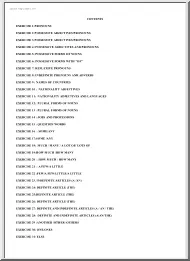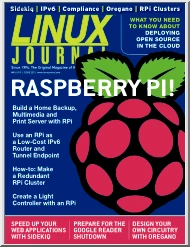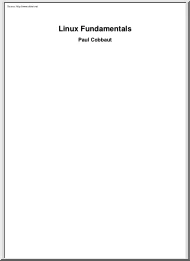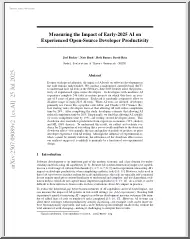Please log in to read this in our online viewer!
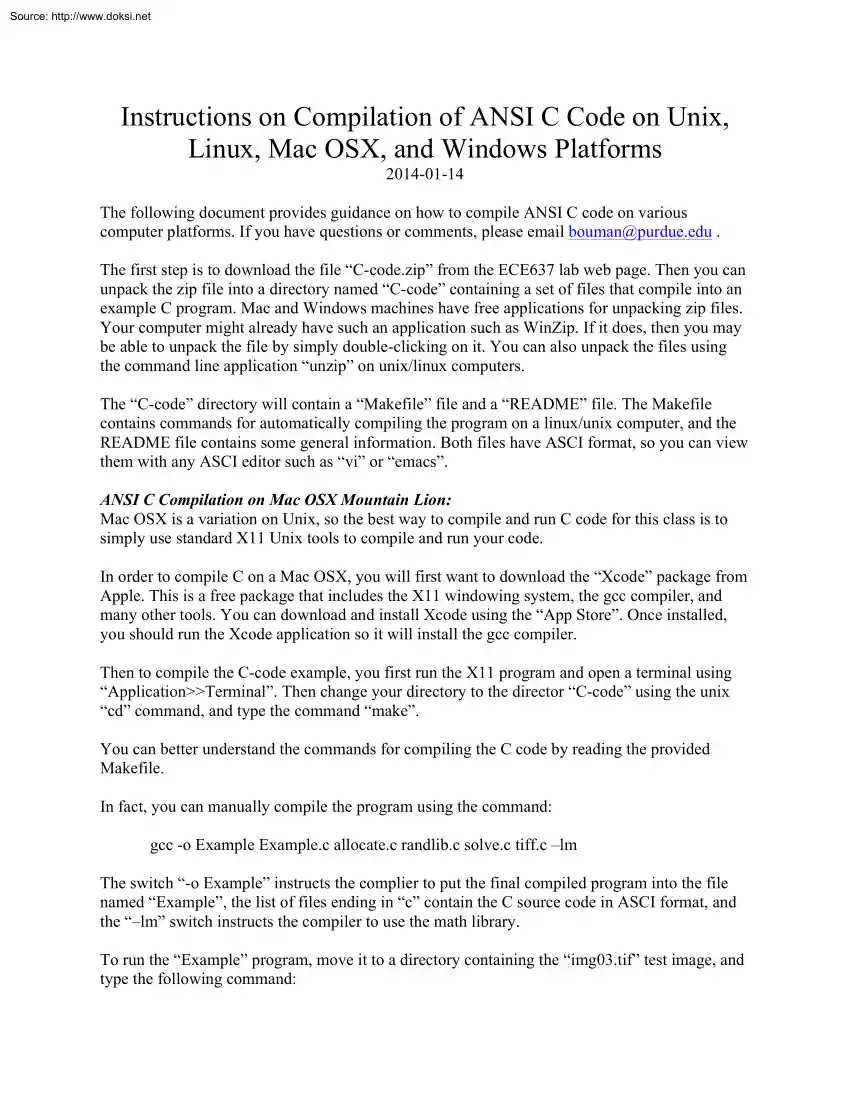
Please log in to read this in our online viewer!
No comments yet. You can be the first!
What did others read after this?
Content extract
Source: http://www.doksinet Instructions on Compilation of ANSI C Code on Unix, Linux, Mac OSX, and Windows Platforms 2014-01-14 The following document provides guidance on how to compile ANSI C code on various computer platforms. If you have questions or comments, please email bouman@purdueedu The first step is to download the file “C-code.zip” from the ECE637 lab web page Then you can unpack the zip file into a directory named “C-code” containing a set of files that compile into an example C program. Mac and Windows machines have free applications for unpacking zip files Your computer might already have such an application such as WinZip. If it does, then you may be able to unpack the file by simply double-clicking on it. You can also unpack the files using the command line application “unzip” on unix/linux computers. The “C-code” directory will contain a “Makefile” file and a “README” file. The Makefile contains commands for automatically compiling the
program on a linux/unix computer, and the README file contains some general information. Both files have ASCI format, so you can view them with any ASCI editor such as “vi” or “emacs”. ANSI C Compilation on Mac OSX Mountain Lion: Mac OSX is a variation on Unix, so the best way to compile and run C code for this class is to simply use standard X11 Unix tools to compile and run your code. In order to compile C on a Mac OSX, you will first want to download the “Xcode” package from Apple. This is a free package that includes the X11 windowing system, the gcc compiler, and many other tools. You can download and install Xcode using the “App Store” Once installed, you should run the Xcode application so it will install the gcc compiler. Then to compile the C-code example, you first run the X11 program and open a terminal using “Application>>Terminal”. Then change your directory to the director “C-code” using the unix “cd” command, and type the command
“make”. You can better understand the commands for compiling the C code by reading the provided Makefile. In fact, you can manually compile the program using the command: gcc -o Example Example.c allocatec randlibc solvec tiffc –lm The switch “-o Example” instructs the complier to put the final compiled program into the file named “Example”, the list of files ending in “c” contain the C source code in ASCI format, and the “–lm” switch instructs the compiler to use the math library. To run the “Example” program, move it to a directory containing the “img03.tif” test image, and type the following command: Source: http://www.doksinet ./Example img03tif The prefix “./” tells the operating system to run the file “Example” contained in the current directory. ANSI C Compilation on Linux platforms: Linux is just a variation on system-V Unix, so it is quite similar to compiling under the Mac OSX. Again, open a terminal window under Linux, and change
directory to the C-code directory Run the command “make” to compile all the source code. As in Mac OSX, it will produce an executable file “Example” that you can run as a command line application. ANSI C Compilation on Linux platforms: Some variations on traditional Unix may have a “cc” complier rather than the “gcc” compiler. If this is the case, then you can edit the “Makefile” to add the following commands: CC = cc CFLAGS = -Xa The remaining operations are the same as in Linux and Mac OSX. ANSI C Compilation on Windows platforms: On windows platforms, you can use MS Visual Studio to compile ANSI C. However, MS Visual Studio will require that you configure it to use plain vanilla ANSI C, rather than the more sophisticated variations to which it typically defaults. The specifics of compiling under Windows vary, but below are rules for compiling under MS Visual Studio 2010. MS Visual Studio 2010: i) File->New->Project. (hotkey CTRL+SHIFT+N) ii) On left frame
of "New Project" window, select Visual C++->General->Empty Project. iii) Enter a project name in the Name field, and select a directory to create the file in. iv) Project->Add Existing Item. (hotkey SHIFT+ALT+A) v) Select desired *.c source files, then click Add vi) Debug->Start Debugging (hotkey F5). It should build and execute Dev-C++: Another option is to use a open source C complier on your Windows platform. For example, you can use the “Dev-C++” software package that is freely available and functions much like the linux compiling environment, but with a graphical user interface. See: www.bloodshednet/devcpphtml
program on a linux/unix computer, and the README file contains some general information. Both files have ASCI format, so you can view them with any ASCI editor such as “vi” or “emacs”. ANSI C Compilation on Mac OSX Mountain Lion: Mac OSX is a variation on Unix, so the best way to compile and run C code for this class is to simply use standard X11 Unix tools to compile and run your code. In order to compile C on a Mac OSX, you will first want to download the “Xcode” package from Apple. This is a free package that includes the X11 windowing system, the gcc compiler, and many other tools. You can download and install Xcode using the “App Store” Once installed, you should run the Xcode application so it will install the gcc compiler. Then to compile the C-code example, you first run the X11 program and open a terminal using “Application>>Terminal”. Then change your directory to the director “C-code” using the unix “cd” command, and type the command
“make”. You can better understand the commands for compiling the C code by reading the provided Makefile. In fact, you can manually compile the program using the command: gcc -o Example Example.c allocatec randlibc solvec tiffc –lm The switch “-o Example” instructs the complier to put the final compiled program into the file named “Example”, the list of files ending in “c” contain the C source code in ASCI format, and the “–lm” switch instructs the compiler to use the math library. To run the “Example” program, move it to a directory containing the “img03.tif” test image, and type the following command: Source: http://www.doksinet ./Example img03tif The prefix “./” tells the operating system to run the file “Example” contained in the current directory. ANSI C Compilation on Linux platforms: Linux is just a variation on system-V Unix, so it is quite similar to compiling under the Mac OSX. Again, open a terminal window under Linux, and change
directory to the C-code directory Run the command “make” to compile all the source code. As in Mac OSX, it will produce an executable file “Example” that you can run as a command line application. ANSI C Compilation on Linux platforms: Some variations on traditional Unix may have a “cc” complier rather than the “gcc” compiler. If this is the case, then you can edit the “Makefile” to add the following commands: CC = cc CFLAGS = -Xa The remaining operations are the same as in Linux and Mac OSX. ANSI C Compilation on Windows platforms: On windows platforms, you can use MS Visual Studio to compile ANSI C. However, MS Visual Studio will require that you configure it to use plain vanilla ANSI C, rather than the more sophisticated variations to which it typically defaults. The specifics of compiling under Windows vary, but below are rules for compiling under MS Visual Studio 2010. MS Visual Studio 2010: i) File->New->Project. (hotkey CTRL+SHIFT+N) ii) On left frame
of "New Project" window, select Visual C++->General->Empty Project. iii) Enter a project name in the Name field, and select a directory to create the file in. iv) Project->Add Existing Item. (hotkey SHIFT+ALT+A) v) Select desired *.c source files, then click Add vi) Debug->Start Debugging (hotkey F5). It should build and execute Dev-C++: Another option is to use a open source C complier on your Windows platform. For example, you can use the “Dev-C++” software package that is freely available and functions much like the linux compiling environment, but with a graphical user interface. See: www.bloodshednet/devcpphtml
